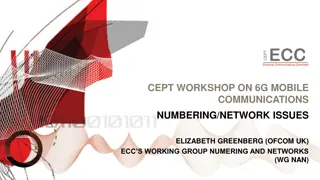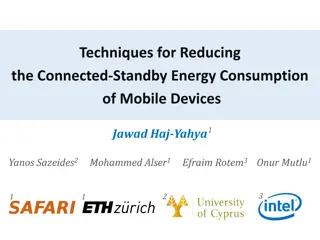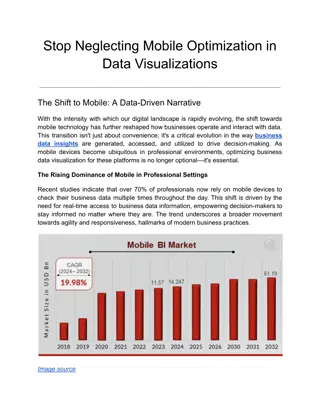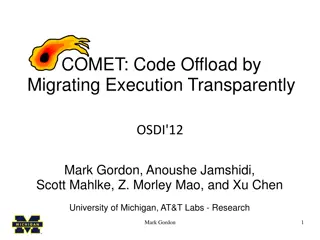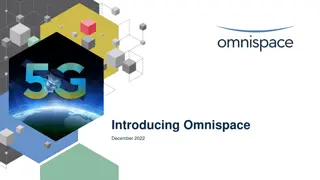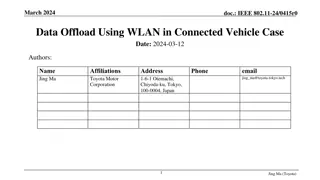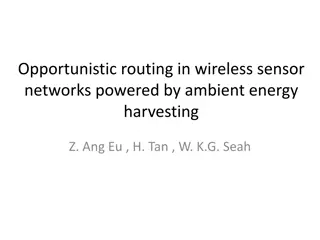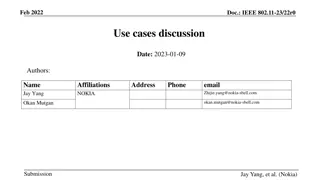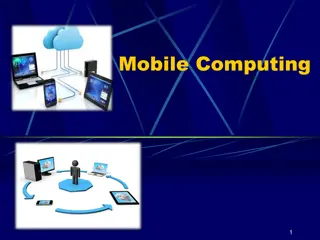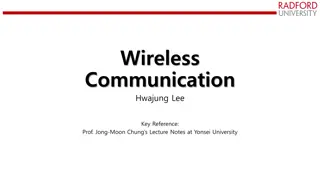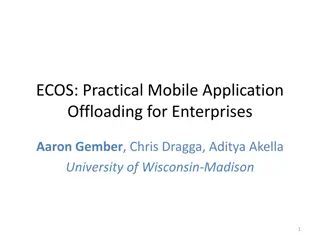Deadline-Sensitive Mobile Data Offloading via Opportunistic Communications
The research explores strategies for efficient mobile data offloading in a deadline-sensitive environment through opportunistic communications. Motivated by the exponential growth of mobile users and data traffic, the study delves into existing offloading models, mobile user behaviors, and the challenges posed by limited network capacities. By formulating offloading scenarios and models, the aim is to minimize data transmission costs while balancing connectivity via WiFi and cellular networks.
Download Presentation

Please find below an Image/Link to download the presentation.
The content on the website is provided AS IS for your information and personal use only. It may not be sold, licensed, or shared on other websites without obtaining consent from the author.If you encounter any issues during the download, it is possible that the publisher has removed the file from their server.
You are allowed to download the files provided on this website for personal or commercial use, subject to the condition that they are used lawfully. All files are the property of their respective owners.
The content on the website is provided AS IS for your information and personal use only. It may not be sold, licensed, or shared on other websites without obtaining consent from the author.
E N D
Presentation Transcript
TEMPLE UNIVERSITY Deadline-Sensitive Mobile Data Offloading via Opportunistic Communications Guoju Gaoa, Mingjun Xiao a, Jie Wub, Kai Hana, Liusheng Huanga a University of Science and Technology of China, China b Temple University, USA
Outline Motivation Problem Solution Example Simulation Conclusion
Motivation Motivation (1) Mobile users will be 5.5 Billion (70% of global population) by 2020, up from 4.8 Billion in 2015, a compound annual growth rate (CAGR) of 2.6%.
Motivation Motivation (2) Mobile data traffic will reach 30.6 Exabytes per month by 2020 (the equivalent of 7,641 million DVDs each month), up from 3.7 Exabytes per month in 2015.
Motivation Motivation (3) 51% of global mobile data traffic was offloaded in 2015; 55% of global mobile data traffic will be offloaded by 2020.
Motivation Motivation Existing offloading models: Offloading based on DTNs formulated as a target-set selection problem, incentive mechanism to attract participants, etc. Offloading based on WiFi economic benefits and load balance problem, maximize profits from the perspective of system, etc.
Motivation Motivation Mobile users: uncertain mobility self-centered (minimizing transmission cost) data with deadlines WiFiAPs lower transmission cost than cellular networks limited capacity due to restricted connect time
Problem Problem Data offloading scenario: A mobile user uploads data items onto the cloud side through WiFi networks when it encounters WiFiAPs during Time-To-Lives (TTLs) of data items, or via cellular networks when the TTLs of data items expire, respectively.
Problem Problem Offloading model: data set : D = {d1, , di, , dn}, di=< si, ti> WiFi set: W = {w1, w2, , wm}, wj=< j, pj, qj> Problem: Given a fixed number of data items and WiFiAPs Minimize the expected data transmission cost
Problem Problem By taking into consideration the transmission capacity of WiFi APs and deadlines of data items, our problem involves a probabilistic combination of multiple 0-1 knapsack constraints.
Solution Solution Adopted greedy strategy including two phases: 1. selecting data offloading operation that increases the offloading utility function value most quickly: 2. selecting the offloading operation, whose data item has the largest data size.
Solution Solution The FDO Algorithm (offline algorithm): the user makes the data offloading decisions before it encounters any WiFiAP.
Solution Solution Approximation ratio of 2: We use optFto denote the optimal offline offloading strategy of optimization problem; We analyze the approximation ratio of FDO, and have the following theorem:
Solution Solution The NDO Algorithm (online algorithm): the data offloading decision is made only when the mobile user encounters the WiFiAPs.
Solution Solution Competitive ratio of 2: The competitive ratio is defined as the ratio of optNand our online solution . We have the following theorem:
Example Example D = {d1, d2, d3, d4}: s1= 8, t1= 11, s2= 6, t2= 13, s3= 5, t3= 17, s4= 10, t4=18. W = {w1, w2}: 1= 10, p1=0.6, q1= 15, 2= 15, p2= 0.9, q2= 10.
Example Example the initial state: feasible offloading operations are determined, according to TTLs of data and appearing time of WiFiAPs.
Example Example Select (d4, w2):
Example Example Select (d1, w1):
Example Example Select (d2, w1): Now, both remaining capacities of w1and w2are smaller than the size of any data items.
Example Example Deadline constraint and capacity constraint are both satisfied. Final offloading strategy is obtained: ={(d1,w1), (d2,w1), (d4,w2)}
Simulation Simulation Settings: Parameter name Number of data items: n Default value Range 50-250 150 Number of WiFi APs: m 15 5-25 Average size of data: s 200 100-500 Average TTL of data: t 100 50-250 Average capacity of WiFi APs: q 3000 1000-5000 Average accessing probability: p 0.2 0.1-0.3
Simulation Simulation Algorithms in comparison: RS (Random Selection) SA (Sequential Allocation) Both RS and SA satisfy deadline and capacity constraints. Metrics: Total transmission cost Offloading Ratio
Simulation Simulation Results: total cost and offloading ratio vs. the number of data items
Simulation Simulation Results: total cost and offloading ratio vs. the number of WiFiAPs
Simulation Simulation Results: total cost vs. average TTLs and sizes of data items, average capacities and accessing probabilities of WiFiAPs
Simulation Simulation Results: offloading ratio vs. average TTLs and sizes of data items, average capacities and accessing probabilities of WiFi APs.
Conclusion Conclusion NDO and FDO algorithms outperforms the compared algorithms in both the total cost and offloading ratio. NDO achieves the best performance, and FDO follows. When the number of data items or the average size of data increases, the total cost increases and the offloading ratio reduces significantly. When the number of WiFiAPs or the average capacity of WiFi APs increases, the total cost decreases and the offloading ratio increases observably. When the average TTL of data or the average probability of accessing WiFiAPs increases, the cost decreases, while offloading ratio increases, respectively.
Thank You! Q&A



